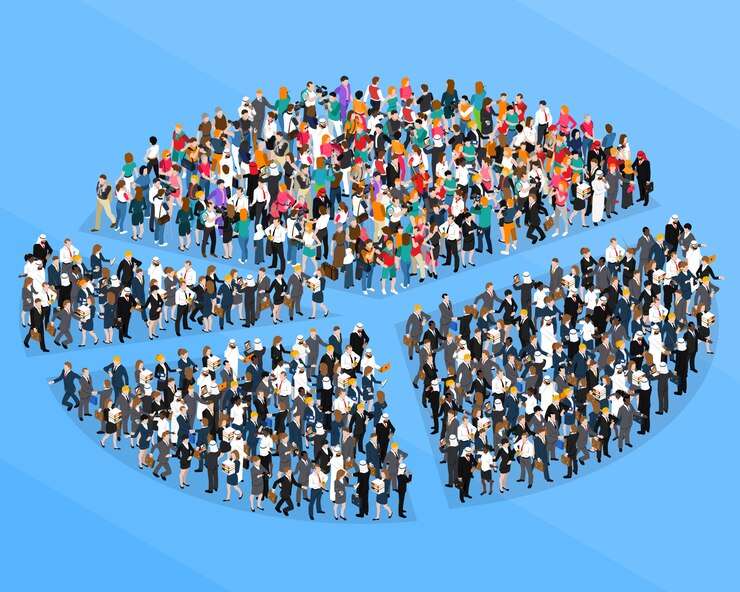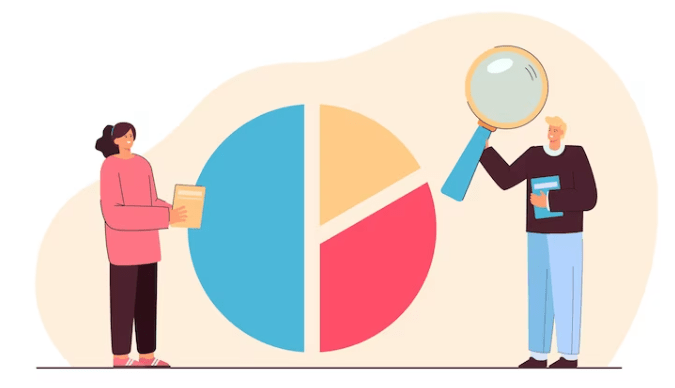TABLE OF CONTENT
ToggleDemography-Nature, Scope and Significance
Hey Mumbai University SYBA IDOL students! Today, we’re diving into the fascinating world of CONTEMPORARY ISSUES IN INDIAN SOCIETY , exploring about – “Demography-Nature, Scope and Significance“. Although the term might sound complex, it simply refers to the study of people.
Demography delves deeper into how many people there are, where they reside, and how these numbers constantly shift over time. Imagine it as deciphering the story of our population – its size, distribution, and continuous evolution. Demography goes beyond just counting heads. It’s like a detective examining clues!
By analyzing birth rates, death rates, age groups, and migration patterns, demographers can paint a clear picture of a society’s composition. It’s like a social snapshot that aids us in comprehending the present and anticipating the future. We’ll dissect its nature and scope, differentiate it from population studies, and uncover its power in shaping our society and economy.
So, SYBA IDOL Mumbai University students, get ready to unwrap the mysteries of “Demography-Nature, Scope and Significance” with customized IDOL notes just for you. Let’s jump into this exploration together


Question 1 :- Can you explain the term Demography?
Demography is the scientific study of human populations with respect to their size, structure, and dynamics. It involves the analysis of the characteristics of human populations, such as their size, distribution, composition, and changes over time. Demography also studies the factors that influence population growth, such as fertility, mortality, and migration. It is an interdisciplinary field that draws on knowledge from various disciplines, including statistics, sociology, economics, geography, and biology. The study of demography is important for understanding the social, economic, and political implications of population growth and change.
Question 2 :- What does Demography Studies?
Demography studies human populations with respect to their size, structure, and dynamics. It involves the analysis of the characteristics of human populations, such as their size, distribution, composition, and changes over time. Demography also studies the factors that influence population growth, such as fertility, mortality, and migration. It is an interdisciplinary field that draws on knowledge from various disciplines, including statistics, sociology, economics, geography, and biology. The study of demography is important for understanding the social, economic, and political implications of population growth and change.
EXERCISE QUESTIONS :-
Question 1 :- Define demography. Examine the nature and scope of demography
Introduction:
Demography, often described as the detective of society, is a scientific study delving into the intricacies of human populations. It goes beyond simple headcounts, painting a comprehensive picture of the size, structure, and dynamics of populations. Comparable to a puzzle, demography examines not just the number of people but also the unique characteristics that define and shape societies over time. This exploration serves as a vital lens through which we gain insights into the composition, growth, and the influencing factors behind these population patterns.
-
Population Characteristics:
- Size: The fundamental count of individuals within a specific region.
- Distribution: How populations are dispersed across various geographical areas.
-
Population Composition:
- Structure: Analyzing the demographic makeup, including age, gender, ethnicity, and more.
- Changes Over Time: Unraveling shifts in population structure due to births, deaths, and migrations.
-
Factors Influencing Population Growth:
- Fertility: Examining the patterns and drivers of birth rates.
- Mortality: Understanding the determinants of death rates.
- Migration: Exploring the movement of individuals between regions.
-
Interdisciplinary Nature:
- Statistics: Employing statistical methods for accurate data analysis.
- Sociology: Incorporating societal perspectives into population studies.
- Economics: Analyzing economic influences on population dynamics.
- Geography: Studying spatial patterns and regional variations.
- Biology: Considering biological aspects related to reproduction and mortality.
-
The Extensive Nature and Scope:
- Population Dynamics: Encompasses the study of population size, growth, and the intricate processes propelling these changes.
- Distribution and Characteristics: Analyzes how populations are spread and the diverse traits that define them.
- Interconnected Factors: Explores the complex relationship between population dynamics and social, economic, and political dimensions.
-
Importance of Demography:
- Social Insight: Provides a deep understanding of societal structures and demographics.
- Economic Analysis: Evaluates workforce trends, labor markets, and economic dependencies.
- Political Decision-Making: Informs policymakers about population-related issues.
- Resource Allocation: Guides distribution based on population needs and demographics.
Conclusion:
In essence, demography stands as a comprehensive compass, guiding societies through the labyrinth of population dynamics. Its interdisciplinary approach ensures a holistic understanding of the implications of population changes, making it an indispensable tool for informed decision-making across various domains. By examining population characteristics, understanding influencing factors, and recognizing the interconnected nature of demographic processes, demography becomes a guidebook for societies. It not only sheds light on the present but also provides valuable insights for navigating the twists and turns of the future, ensuring wise decisions in the realms of social, economic, and political planning.
Question 2 :- Examine the significance of demography to the economy and society
Introduction:
Demography, the science of understanding human populations, is like a guidebook for shaping our society. It’s not just about numbers; it’s about understanding why people live where they live, how they grow, and what challenges they face. This study is a crucial tool that helps us plan for a better future. Today, we’ll explore why demography is so important, focusing on economic planning, administration, political systems, economic growth, and social planning. Buckle up as we unravel the significance of demography in simple terms that everyone can grasp.
-
Economic Planning:
- Path for Future Planning: Demography acts as a compass for economic planning. It helps us understand how our population is growing and where people are moving. This knowledge guides strategies in areas like farming, industries, and providing essential services such as healthcare and education.
- Policy Formulation: By studying population trends, we can make policies about family planning, ensuring that our population growth is balanced with the resources we have.
-
Administration:
- Insights for Administrators: Population studies provide important insights for administrators. They help in making smart strategies to address challenges caused by population growth, like in cities where more people are moving, causing issues like slums and pollution.
- Targeted Solutions: Demography helps in implementing solutions to problems, like making sure there’s clean water and good sanitation facilities where they are needed.
-
Political System:
- Foundational Information: The data we get from demography, especially from the census, is like the foundation of our political system. It helps political parties plan their strategies for elections and create manifestos.
- Informed Governance: Understanding how our population is changing, who is voting, and how people are moving is crucial for making smart decisions in governance.
-
Economic Growth:
- Understanding the Dynamics: Demography shows us how population growth is connected to economic development. It highlights potential challenges like unemployment and problems with the environment.
- Sustainable Growth: By understanding and dealing with problems linked to rapid population growth, demography helps in achieving economic growth that can be sustained over time.
-
Social Planning:
- Essential for Services: Demography is like a guide for planning social services. It helps answer questions about healthcare, education, transportation, sanitation, and housing.
- Proactive Measures: By studying demography, we can plan ahead, estimating how many students will be in schools, predicting the need for services, and understanding the root causes of social problems.
Conclusion:
In a nutshell, demography is like a superpower that helps us understand the complicated dynamics of human populations. It’s not just about counting people; it’s about using that knowledge to shape our economic, administrative, political, and social future. By providing insights into trends and characteristics, demography becomes a crucial tool for steering our society toward a more informed and sustainable future. It’s not just for experts; it’s for everyone who wants to make better decisions for our shared tomorrow.
Question 3 :- Discuss the relation between demography and population studies. Elaborate on the nature and scope of demography
Introduction:
Let’s dive into the world of understanding people and populations. Demography and population studies may sound a bit confusing, but they’re like two sides of the same coin, each with its unique focus. Think of demography as the numbers guru, crunching stats about how many people there are and how they change. On the flip side, population studies spread a wider net, exploring all the whys and hows behind these changes. Today, we’re unraveling these concepts in a way that even the newcomers to this field, like you, can grasp easily.
-
Nature and Scope of Demography:
- Vast Encompassment: Demography dives into the nitty-gritty of population dynamics, analyzing how it grows, shrinks, and the key drivers behind these changes.
- Interconnected Exploration: It’s not just about numbers; demography shows how population shifts dance with social, economic, and political factors.
- Interdisciplinary Approach: Demography is like a team player, using insights from statistics, sociology, economics, geography, and biology to see the full picture.
- Importance of Demography: Picture it as a superhero tool for decision-makers. It helps them make smart choices about population-related issues, understand economic trends, and unravel the secrets of societal structures.
-
Nature and Scope of Population Studies:
- Broader Spectrum: Now, population studies take the stage, expanding beyond the numbers to embrace a wider understanding. It’s like demography’s cool cousin.
- Holistic Investigation: It goes beyond the math, exploring the social, economic, and environmental aspects of population changes.
- Diverse Disciplinary Contributions: Imagine it as a melting pot, mixing knowledge from sociology, economics, geography, biology, and, of course, demography.
Conclusion:
So, whether you’re into numbers or the stories behind them, demography and population studies are your go-to guides. They’re not just subjects; they’re keys to unlocking the mysteries of human populations. As you journey through this realm, remember that every change in population isn’t just a shift in numbers; it’s a story waiting to be told. Together, demography and population studies light up the path, helping us understand, analyze, and navigate the intriguing dynamics of the human tapestry. And as you unravel these concepts, you’re not just learning; you’re becoming a part of the team that shapes the future.
Important Note for Students :– Hey everyone! All the questions in this chapter are super important!
